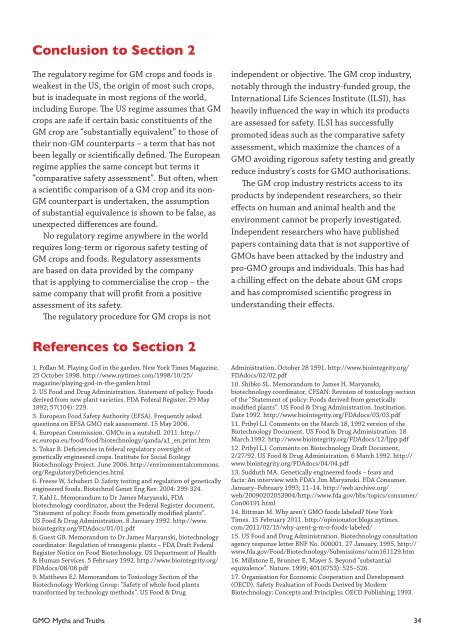GMO Myths and Truths
GMO Myths and Truths
GMO Myths and Truths
You also want an ePaper? Increase the reach of your titles
YUMPU automatically turns print PDFs into web optimized ePapers that Google loves.
Conclusion to Section 2<br />
The regulatory regime for GM crops <strong>and</strong> foods is<br />
weakest in the US, the origin of most such crops,<br />
but is inadequate in most regions of the world,<br />
including Europe. The US regime assumes that GM<br />
crops are safe if certain basic constituents of the<br />
GM crop are “substantially equivalent” to those of<br />
their non-GM counterparts – a term that has not<br />
been legally or scientifically defined. The European<br />
regime applies the same concept but terms it<br />
“comparative safety assessment”. But often, when<br />
a scientific comparison of a GM crop <strong>and</strong> its non-<br />
GM counterpart is undertaken, the assumption<br />
of substantial equivalence is shown to be false, as<br />
unexpected differences are found.<br />
No regulatory regime anywhere in the world<br />
requires long-term or rigorous safety testing of<br />
GM crops <strong>and</strong> foods. Regulatory assessments<br />
are based on data provided by the company<br />
that is applying to commercialise the crop – the<br />
same company that will profit from a positive<br />
assessment of its safety.<br />
The regulatory procedure for GM crops is not<br />
References to Section 2<br />
1. Pollan M. Playing God in the garden. New York Times Magazine.<br />
25 October 1998. http://www.nytimes.com/1998/10/25/<br />
magazine/playing-god-in-the-garden.html<br />
2. US Food <strong>and</strong> Drug Administration. Statement of policy: Foods<br />
derived from new plant varieties. FDA Federal Register. 29 May<br />
1992; 57(104): 229.<br />
3. European Food Safety Authority (EFSA). Frequently asked<br />
questions on EFSA <strong>GMO</strong> risk assessment. 15 May 2006.<br />
4. European Commission. <strong>GMO</strong>s in a nutshell. 2011. http://<br />
ec.europa.eu/food/food/biotechnology/q<strong>and</strong>a/a1_en.print.htm<br />
5. Tokar B. Deficiencies in federal regulatory oversight of<br />
genetically engineered crops. Institute for Social Ecology<br />
Biotechnology Project. June 2006. http://environmentalcommons.<br />
org/RegulatoryDeficiencies.html<br />
6. Freese W, Schubert D. Safety testing <strong>and</strong> regulation of genetically<br />
engineered foods. Biotechnol Genet Eng Rev. 2004: 299-324.<br />
7. Kahl L. Memor<strong>and</strong>um to Dr James Maryanski, FDA<br />
biotechnology coordinator, about the Federal Register document,<br />
“Statement of policy: Foods from genetically modified plants”.<br />
US Food & Drug Administration. 8 January 1992. http://www.<br />
biointegrity.org/FDAdocs/01/01.pdf<br />
8. Guest GB. Memor<strong>and</strong>um to Dr James Maryanski, biotechnology<br />
coordinator: Regulation of transgenic plants – FDA Draft Federal<br />
Register Notice on Food Biotechnology. US Department of Health<br />
& Human Services. 5 February 1992. http://www.biointegrity.org/<br />
FDAdocs/08/08.pdf<br />
9. Matthews EJ. Memor<strong>and</strong>um to Toxicology Section of the<br />
Biotechnology Working Group: “Safety of whole food plants<br />
transformed by technology methods”. US Food & Drug<br />
independent or objective. The GM crop industry,<br />
notably through the industry-funded group, the<br />
International Life Sciences Institute (ILSI), has<br />
heavily influenced the way in which its products<br />
are assessed for safety. ILSI has successfully<br />
promoted ideas such as the comparative safety<br />
assessment, which maximize the chances of a<br />
<strong>GMO</strong> avoiding rigorous safety testing <strong>and</strong> greatly<br />
reduce industry’s costs for <strong>GMO</strong> authorisations.<br />
The GM crop industry restricts access to its<br />
products by independent researchers, so their<br />
effects on human <strong>and</strong> animal health <strong>and</strong> the<br />
environment cannot be properly investigated.<br />
Independent researchers who have published<br />
papers containing data that is not supportive of<br />
<strong>GMO</strong>s have been attacked by the industry <strong>and</strong><br />
pro-<strong>GMO</strong> groups <strong>and</strong> individuals. This has had<br />
a chilling effect on the debate about GM crops<br />
<strong>and</strong> has compromised scientific progress in<br />
underst<strong>and</strong>ing their effects.<br />
Administration. October 28 1991. http://www.biointegrity.org/<br />
FDAdocs/02/02.pdf<br />
10. Shibko SL. Memor<strong>and</strong>um to James H. Maryanski,<br />
biotechnology coordinator, CFSAN: Revision of toxicology section<br />
of the “Statement of policy: Foods derived from genetically<br />
modified plants”. US Food & Drug Administration. Institution.<br />
Date 1992. http://www.biointegrity.org/FDAdocs/03/03.pdf<br />
11. Pribyl LJ. Comments on the March 18, 1992 version of the<br />
Biotechnology Document. US Food & Drug Administration. 18<br />
March 1992. http://www.biointegrity.org/FDAdocs/12/ljpp.pdf<br />
12. Pribyl LJ. Comments on Biotechnology Draft Document,<br />
2/27/92. US Food & Drug Administration. 6 March 1992. http://<br />
www.biointegrity.org/FDAdocs/04/04.pdf<br />
13. Sudduth MA. Genetically engineered foods – fears <strong>and</strong><br />
facts: An interview with FDA’s Jim Maryanski. FDA Consumer.<br />
January–February 1993; 11–14. http://web.archive.org/<br />
web/20090202053904/http://www.fda.gov/bbs/topics/consumer/<br />
Con00191.html<br />
14. Bittman M. Why aren’t <strong>GMO</strong> foods labeled? New York<br />
Times. 15 February 2011. http://opinionator.blogs.nytimes.<br />
com/2011/02/15/why-arent-g-m-o-foods-labeled/<br />
15. US Food <strong>and</strong> Drug Administration. Biotechnology consultation<br />
agency response letter BNF No. 000001. 27 January. 1995. http://<br />
www.fda.gov/Food/Biotechnology/Submissions/ucm161129.htm<br />
16. Millstone E, Brunner E, Mayer S. Beyond “substantial<br />
equivalence”. Nature. 1999; 401(6753): 525–526.<br />
17. Organisation for Economic Cooperation <strong>and</strong> Development<br />
(OECD). Safety Evaluation of Foods Derived by Modern<br />
Biotechnology: Concepts <strong>and</strong> Principles: OECD Publishing; 1993.<br />
<strong>GMO</strong> <strong>Myths</strong> <strong>and</strong> <strong>Truths</strong> 34


